We are here! We arrived in Santiago de Cuba early Sunday afternoon, a full day ahead of our plans. Plans are always a wish and a prayer on a boat. Our brilliant weather router, Chris Parker, warned us that we’d better get through the Windward Passage before mid-Monday, and now I’m so glad we tackled that nasty bit of water even earlier. The sea state in the passage reminded me of what you see when you lift the lid on your washing machine and watch it agitate your clothes, only on a far, far greater scale. As you can imagine, in the dark, this was a terrifying bit of the trip for me. Maybe it’s a good thing that our first night out was about as idyllic as any landlubber could wish. I spent a good deal of the first night watching the stars. For the first time in my life I followed the course of Sirius and Orion completely across the sky to watch them set in the west at about 3am, just a short time before the moon rose.
That second night, approaching the eastern coast of Cuba and then entering the Windward Passage was exactly what I’ve always tried to avoid.
When dawn arrived on Sunday morning we were awestruck by the huge mountain range on the southern coast of Cuba. It is monumental!…like some of the island chains in Greece, or in Southeast Asia. What a view to discover as dawn flooded the horizon.
Passing Guantanamo in the morning kept me thoroughly riveted. It is a much more impressive compound than I ever imagined. It is far more than just a prison, and has large buildings dominating the shoreline, along with gigantic wind generators high up on the nearby mountains. Clearly, the US Navy has to supply all of their own needs here. As we approached the no-sail zone a high speed navy skiff rushed toward us. I was worried that perhaps we had crossed into the off limits area, but the navy boat stopped about half a mile inshore from us and then matched its speed to ours to shadow us all the way down that 100mile excluded zone of water. I wanted to wave to them, but wasn’t certain how they’d react. Surely they could easily our large American ensign flying at our stern, but still…. In the end I opted for not waving. The entrance to the harbor was quite amazing, a real natural wonder, being narrow and long and deep. All these mountains rise up for a couple thousand feet, and plunge into the water even deeper so that even a couple of miles offshore we were in very deep water. I guess I always imagined Guatanamo being a bit of backwater. If it is, the other US Navy outposts must really be something! When we passed the final border of the no-sail zone the navy boat stopped and watched us for a bit before returning to their post.
Finding Guantanamo so impressive should have prepared me for the first sight of Santiago de Cuba, but I was again unprepared for such a dramatic sight. This is one of the earliest settled areas of Cuba, and on the bluff that overlooks the entrance to the harbor is the thoroughly magnificent Castillo de Morro, built by the Spanish around 1587 to protect the settlement from invasions by pirates, who had sacked this city in 1554. Santiago de Cuba was the capitol of Cuba until 1607, when Havana took that role. In appearance, Castillo de Morro is the big brother of that fort in St. Augustine, Florida. In modern history, this is where Fidel launched revolution.
Santiago de Cuba was founded in 1510 and became the capitol of the Spanish settlement around 1515, after Barracoa had been the capitol for some years. Santiago de Cuba is actually closer to Haiti (across the Windward Passage) and to Jamaica than it is to Havana, so it has a mixed Caribbean culture that differs from other Cuban cities. I’m looking forward to discovering a bit about this.
Entering the harbor under the view of such a fort made me realize just how far we’ve come on this journey to visit the ‘forbidden gem of the Caribbean.’ It’s all been speculation and endless bureaucratic forms. Passing under that early colonial fortress suddenly made me realize that our long planning and speculating had become a reality! I’m really here!
This is a stunning harbor, with mountains rising on all sides of the harbor, mostly undeveloped. In the pleasure boat part of the harbor, which is the first part as you enter, there is a jolly sense of decayed luxury: a charming marina that must have once been quite a bit more than charming. The same kind of small mildly decayed hotel and two restaurants are adjacent to the marina. It is a lovely spot. Further down the harbor is a large commercial port that has more ships than I can count at any given time. These ships are constantly coming and going, so as we sit at anchor in our idyllic spot of the harbor with mountain views all around and just the few little vestiges of some previous luxury now run to disrepair, we’ll suddenly find our quiet view completely obliterated by some behemoth ship passing in or out. It is quite a sight!
The check in process was quite an experience. In one guidebook I read that Cuba is a very confusing place for Americans, and the best way to handle it is to just ‘go with the flow.’ Clearly that writer for Lonely Planet thinks this is a challenge for many Americans. Hmmm… Well, that has proven true on our first experience with dealing with customs and immigration. I did try to find out as much as I could before arriving so that we would have the appropriate things ready and not cause any concerns with officials. But of course I know that no matter where one travels, you simply cannot prepare for everything! So it is only a little surprising to me that nothing I read matched what actually happened! And it was a thoroughly enjoyable, albeit confusing, experience.
We’d read that dairy products and chicken are not allowed in Cuba. Some sources said that no meat of any kind could be brought into Cuba. We’d been told by some cruisers in the Bahamas that we’d also have to give up all our fresh produce. Great…I’d be trying out the procedure of washing the local veggies in silver nitrite, to avoid the possibility of Hepatitis A which we neglected to do, sooner than I had hoped. Well, we have a freezer full of meat! In preparation for at least having all our chicken confiscated, we have been eating nothing but for about three weeks! We’ve even had a couple of dinner parties onboard that featured chicken in order to get rid of as much of it as possible. We’d also read that in the larger ports the officials would speak English, so I was very glad that Santiago de Cuba would be our first stop. More time for me to learn Spanish in preparation for the rural stops in the future.
Our first guest onboard from the customs and immigration department was a woman who would check our general health and then go through our food. She was not in the least bothered by our frozen chicken. Perhaps she might have confiscated any fresh chicken if we’d had it. She barely spoke English, although her English was certainly far superior to my Spanish. With the assistance of the various Spanish books we have on hand I think we mostly understood each other. She was not concerned about our horde of cheeses or our two half gallons of milk (one in the freezer for future use).
We’d been told that no one asks for beer or alcohol anymore, but that we should have some soda on hand…there are no American products in Cuba, so having a Coke is quite a treat. We were ready with that, and when we offered our visitor a cold drink she promptly agreed. But then stashed the can of Coke away in her purse! Somewhat later she asked for us to “salut” each other, and although her attempt at describing what she meant sounded like we were going to take her to a bar on the dock, eventually it became clear that she wanted a beer onboard Pandora in order to welcome us to Cuba! She must have really wanted that beer because it took Bob and I an age to understand what she was trying to convey! So we gave her a beer and listened to her tell us about her family, show us photos of her young daughter who is her ‘princess,’ and answer her questions about our life in the US and our children. When she asked for a little money, we were happy to oblige. The whole process was rather enjoyable, and after all she’d just let us keep a staggering array of wonderful cheeses that we brought from the US and Nassau, milk for our morning coffee along with my precious herb plants and pretty pink geranium and my newly sprouting avocado seed!
We lowered our yellow “Q” flag (for Quarantine) and raised the Cuban flag on our starboard shroud and up anchored to head for the marina. There was no room for us at the dock –perhaps a good thing…time will tell—so we anchored yet again. We still had the young lady health official onboard, and she was surprised to see me take the helm while Bob dealt with the anchor. She asked me if I was the ‘Capitan,” and I laughed and said no! But I believe she may have said something the customs official when we all arrived onshore, because he had already put me down as the captain. I find this hilarious, and now for our entire stay in Cuba the officials will all be talking to me rather than Bob.
So it fell to me to be interviewed by the Customs and Immigration official while a tv in the background (hanging from the ceiling) played a Cuban soap opera and then an old episode of “Flipper.” Through that cacophony of noise I tried to understand his Spanish and attempts at English. He was far better understanding me than I was at understanding him! And he was clearly more used to the distracting tv noise than I was. After the interview and paperwork, he came onboard to inspect our boat and look for contraband –guns, drugs, pornography. But before he began the search (no dogs involved in this search, although we’d been warned that larger ports would use them) he sat down at our dining table and asked for a beer. Luckily we had one more chilled beer. (We will be challenged to have enough beer for all the ports we will be visiting….we certainly didn’t get accurate information about this!) He did not make as much small talk as his predecessor, but seemed to go into a relaxed state to enjoy his beer. It was a Yuengling, and he told us it was much stronger than what he was used to having. I asked him if knew of the US city Philadelphia, and when he said he did, I told him he was drinking a beer from that city. He recommended we try a very strong rum called Havana Cru. I guess Bob will be looking for that soon.
Once we were cleared in to Cuba we realized that no one had collected the fees for all the various things we’d heard would be charged. It should have cost us somewhat more than $25 for entering the country, and we’d read that we’d be paying $2.50/day for Cuban health insurance. But all we did was serve some beer and give a small tip.
So we awoke today, our first full day in Cuba, to a cool breeze coming down from the mountains and hot sun in this beautiful harbor. On one side of us is boat with a Norwegian flag, and on the other side is a boat flying a Swedish flag. The dock has several boats flying the French flag and one boat from Denmark. We do not see any US flags here, but then we are not flying our own. We’d been warned by the New Zealanders who gave us lots of information back in January, that a couple of ports, and Santiago de Cuba (the home of the Rebellion) for sure, would not be happy to see the US flag in their waters. If we had thought to bring along a small, discreet ensign we might have flown it, but what we have is an embarrassingly HUGE US flag given to us by our son Rob. It’s a wonderful sight flying off our stern, but not worth causing insult or injury here.
What to do first??? See the castle? Go into the city of Santiago de Cuba, about a 15 minute cab ride from here? Time to immerse ourselves in the local scene. It’s hard to believe we are finally here.

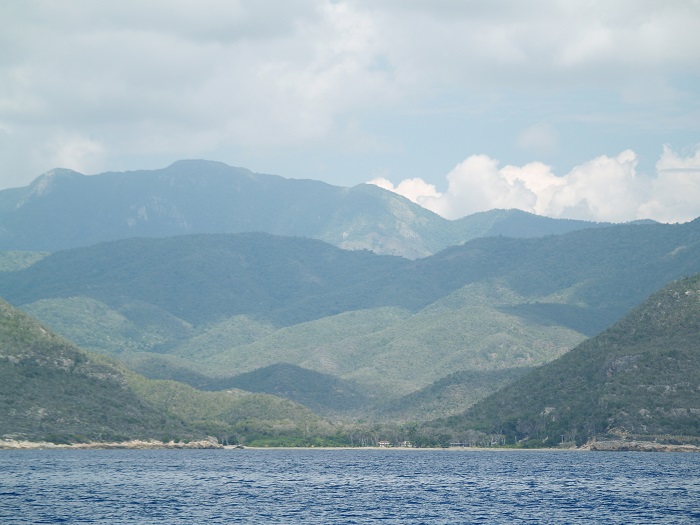
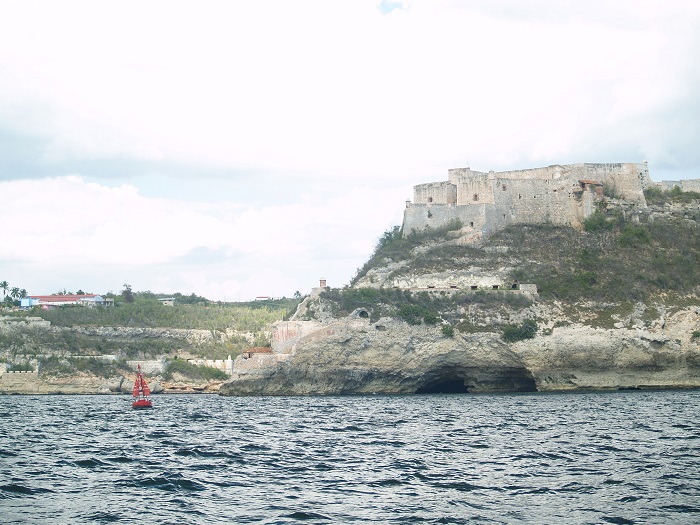
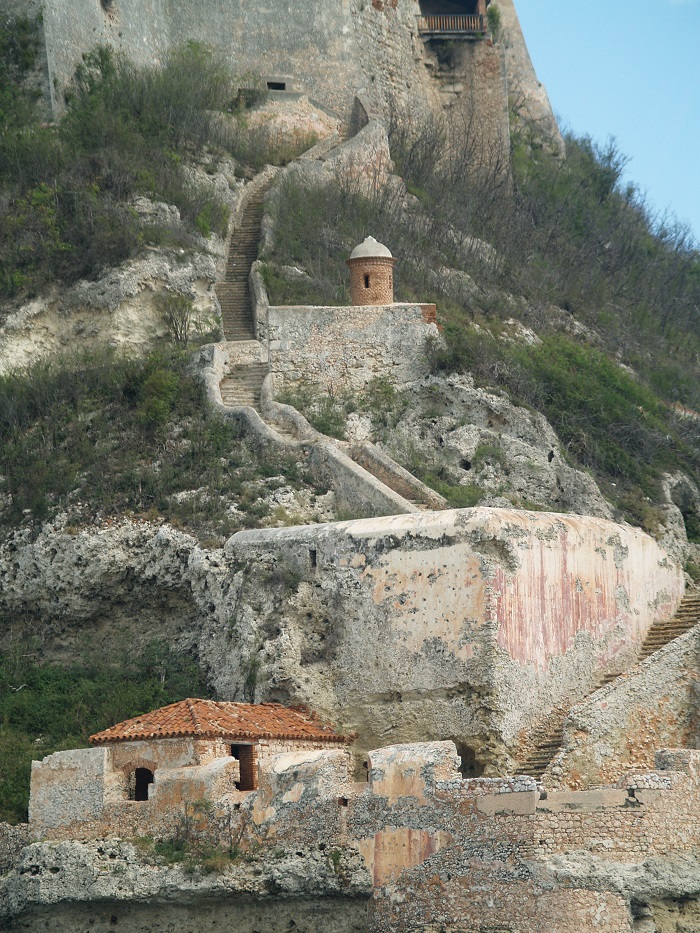
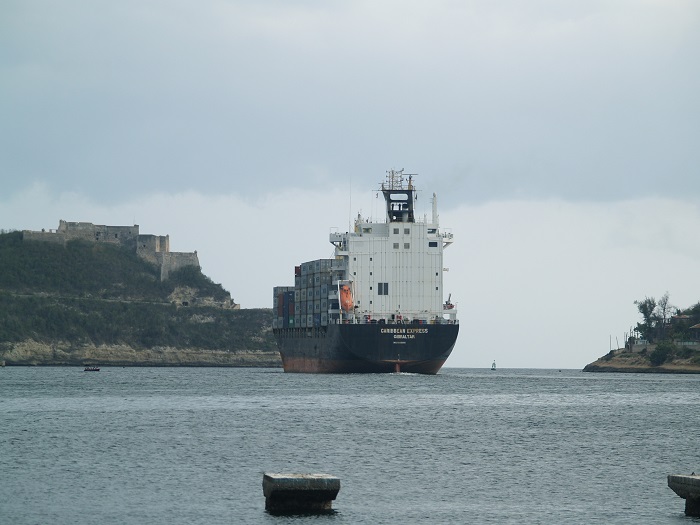

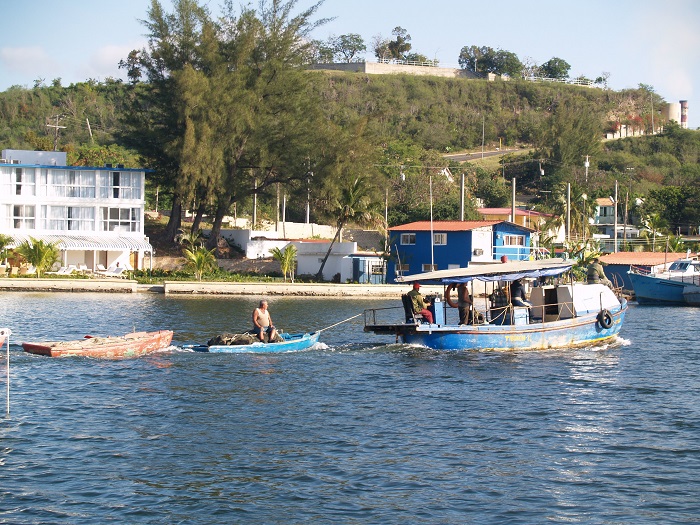
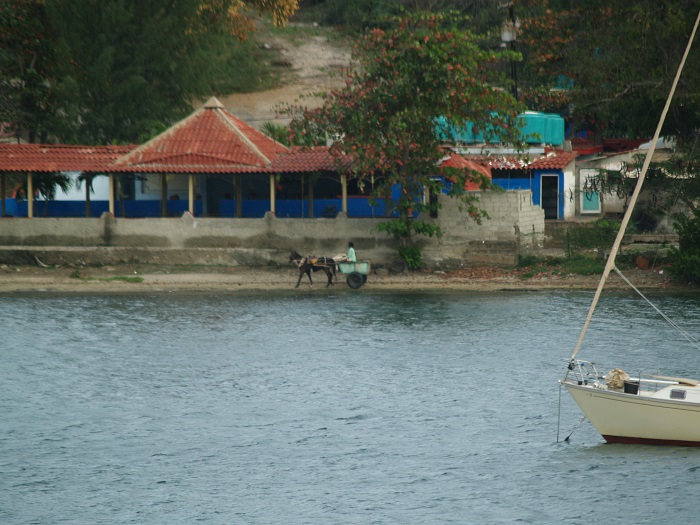
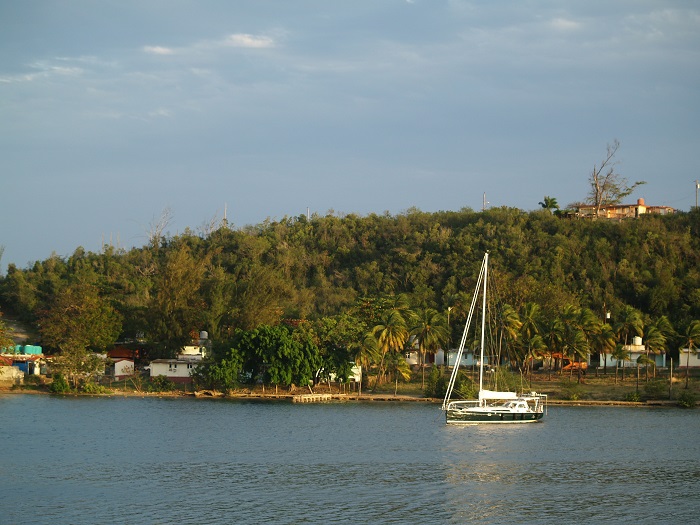
Glad you arrived safely, Brenda, and wonderful reading your account from here in South Yorkshire. Best wishes to you and Bob, Ann Littlewood.
I am so enthralled reading all about your adventure! I am right there with you as I read. If you get a chance to walk any of the beaches, maybe you could pocket some interesting shells and/or stones for me to use in my clay work??? I’m looking forward to your next entry into your blog!! I send you both big hugs! Jody
Glad you made it Captain Brenda
Pingback: Welcome to Santiago de Cuba. | Sail Pandora